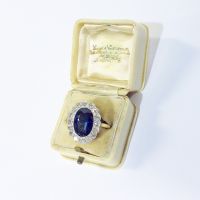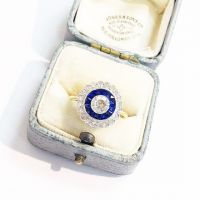How Diamonds Are Set in Rings
There are a variety of ways diamonds can be set in rings. Each setting showcases the diamond differently in order to draw our eye. We’ve explored some of the most popular diamond ring settings, so you’re well informed the next time you go jewellery shopping.
Three stone setting
In a three stone setting, the stones are set closely next to each other. In some rings, the jewels are all the same colour, while in other cases two different coloured stones might be used. The sizes of the stones can vary from design as well; some rings have stones all the same size while others feature a larger centre stone.

Prong Setting
The prong setting is a classic, and also the most common. In a prong setting, the diamond is held by tiny metal claws that grip the stone in place and the shape of the prong can vary for stylistic reasons. It’s common to see either 4 or 6 prongs on a ring; 4 allows you see the diamond better and allows more light to pass through it, adding to its brilliance, while 6 is more secure. The most common prong setting is the solitaire as it draws all the attention to the gemstone.
Something to consider: prongs can snag on clothing or materials, so if you can, have the prongs inspected so you don’t run into any issues.
Pavé Setting
The pave setting gets its name from the French word ‘to pave’ because the band is literally paved with diamonds. This setting has minimal metalwork on show and with the diamonds so closely set, the ring sparkles continuously. To set diamonds like this, holes are drilled into the ring’s band which is where the diamonds are placed. Mini prongs or beads are used to secure each diamond.
Something to consider: the smaller diamonds in pavé setting draw the eye to the larger centre stone.
Antique

Antique rings have designs that fit a specific time period, for instance, the Edwardian or Victorian era. The design of these rings tends to be quite intricate with details such as filigree and milgrain.
Filigree is a delicate form of metalwork that solders tiny beads or twisted threads of metal the surface of the gem.
Milgrain is a type of engraving, it embellishes the band and crown of the ring with tiny decorative balls of metal. It gives some rings that ‘antique’ look.
Cluster Setting

As the name suggests, in a cluster setting the stones are clustered together to create the illusion of a larger stone. This type of setting can include smaller stones of equal size gathered together or a larger centre stone.
Split Shank Setting
The shank is the band of the ring that circles the finger. A split shank refers to a ring with a band that splits into two. Some split shank designs merge the shank ends into prongs that hold the diamond, while others look as though the diamond is resting atop of the split shank. In this design the shank can be covered in pavé set diamonds which help draw the eye to the centre diamond again.
The ways a diamond is set can massively alter the design and we have all of the aforementioned settings in stock. If you’d like to see them up close you can visit us at our Margate branch, or check our current stock.




